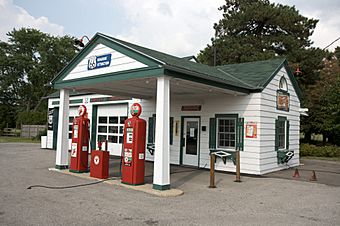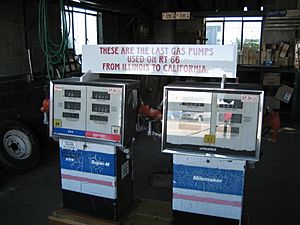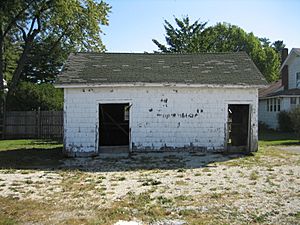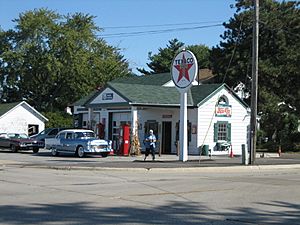Ambler's Texaco Gas Station facts for kids
Quick facts for kids |
|
|
Ambler's Texaco Gas Station
|
|

The station in 2008
|
|
| Location | Dwight, Livingston County, Illinois |
|---|---|
| Area | less than one acre |
| Built | 1933 |
| Architect | Jack Shore (builder) |
| MPS | Route 66 through Illinois MPS |
| NRHP reference No. | 01001311 |
| Added to NRHP | November 29, 2001 |
The Ambler's Texaco Gas Station, also known as Becker's Marathon Gas Station, is a special historic filling station. You can find it where Old U.S. Route 66 and Illinois Route 17 meet in Dwight, Illinois, United States. This station holds a cool record: it was the longest-running gas station along the famous Route 66! It sold fuel for 66 years straight until 1999.
The station looks like a small house, which was a popular style for gas stations back then. It gets its names from two important owners. There's also an old building nearby that used to be an icehouse. The Ambler's station got a big makeover between 2005 and 2007. In May 2007, it reopened as a visitor center for Route 66. Because of its history, it was added to the U.S. National Register of Historic Places in 2001.
Contents
A Look Back at the Station's History
The Ambler's Texaco Station was built in 1933 by Jack Schore in Dwight, Illinois. Even though it doesn't sell gas anymore, it was once the longest-operating gas station on historic Route 66. It stopped selling gasoline in 1999.
In 1936, Vernon Von Qualen leased the station, and it became known as Vernon's Texaco Station. He later bought it and then sold it in 1938 to Basil "Tubby" Ambler. Ambler owned the station for a long time, from 1938 to 1966. Because he owned it during its most important historical period, it was known as Ambler's for many years.

Phil Becker, who owned the station when it was added to the National Register of Historic Places, grew up nearby. He started working at the station in 1964 when he was just nine years old. A year later, Ambler sold the station to Earl Kochler. Then, Royce McBeath ran it from 1965 to 1970.
Becker finally bought the station himself on March 4, 1970. About a year later, Texaco stopped supplying gas. So, Becker started working with Marathon Oil. This change meant the station's name became Becker's Marathon Gas Station, and it kept that name for over 26 years. Phil and his wife Debbie ran the station until 1996. After closing, they leased it out as a car repair shop. Eventually, they gave the building to the village of Dwight.
In 2005, a plan began to fix up the old gas station. The village of Dwight received a grant from the U.S. National Park Service to help with the costs. The goal was to reopen the station as a rest stop and a place where visitors could learn about Route 66.
Bringing the Station Back to Life: Restoration
The restoration project, paid for by the grant and the village, included fixing doors, windows, and the roof. They also repainted the inside and outside to match the station's colors from the 1940s.
On April 24, 2007, the National Park Service placed a special plaque at the station to celebrate the restoration. In early May 2007, after all the work was done, Ambler's Texaco Gas Station opened its doors again as a visitor's center.
Now, when you step inside, it feels like you've traveled back to the 1940s! You can see an old potbelly stove, tiny Coca-Cola bottles, and vintage yardsticks with ads. There's also an old cash register, old 7 Up bottles, and a plaid stamp saver book. The village of Dwight now owns this beautifully restored station.
The Station's Unique Design: Architecture
The Ambler's Texaco Station is built in a common style called "house and canopy" or "domestic style." This design was created in 1916. It featured a small building that looked like a house with a roofed area, or canopy, attached. This canopy extended over the pumps to keep customers dry from the weather. The idea was to make travelers feel at home and comfortable, so they would feel good about buying things there.
The station is a one-story building without a basement. Originally, it only had the house part and the canopy, along with three Texaco gas pumps. The "house" part includes the main office and the men's and women's restrooms. The men's restroom is inside, while the women's restroom has its own outside door. You can still see the original "LADIES" sign above that door.
The main part of the station is about 23 feet long and 14 feet wide. The outside of the building is made of wood with clapboard siding. However, the garage bay area is made of concrete block. This garage bay was added during World War II (between 1941 and 1945). Because materials were hard to find then, they had to use different building supplies.
The building has a wooden roof that slopes down on two sides, covered with asphalt shingles. This roof extends over the station's canopy. The supports for the canopy used to spread out at the bottom, but they have been changed since the station was first built. The three original Texaco pumps were replaced with Marathon pumps from the 1960s, which are now on display. When Marathon took over, a "Marathon" sign was put on the roof of the service bay, but it's not there anymore.
The Old Icehouse

Just north of the Ambler's Texaco Gas Station, there's another wooden building. It's about 24 feet long and 16 feet wide. This building used to be a commercial icehouse. We don't know the exact years it operated, but it's thought that Jack Schore's family started it in the 1930s.
When the icehouse was in business, there was a small pond about 200 feet east of the property. Workers would cut ice from this pond and store it in the building until they sold it. After the icehouse stopped operating, the building was used as a storage shed for the gas station. The building has double walls with sawdust packed in between them to keep it insulated. Its wooden roof is covered with asphalt shingles. The icehouse is considered an important part of the Ambler's Texaco Station's listing on the National Register.
Why This Station is Important
The Ambler's Texaco Station is a great example of the "house and canopy" style of gas station. It was nominated to the National Register of Historic Places in October 2001 and officially listed on November 29, 2001, because of its architecture and its importance to businesses.
From a business standpoint, the station was very important for the services it offered travelers on U.S. Route 66. It provided fuel, oil, and car repairs. The gas station met all the requirements to be added to the National Register. For gas stations along Route 66 in Illinois to be listed, they must clearly show a connection to the early days of traffic and tourism on the route. A station like Ambler's, listed for its architecture, must be a "good example" of its style. This means everything from its design to its location must show its historic look and feel along Route 66.




